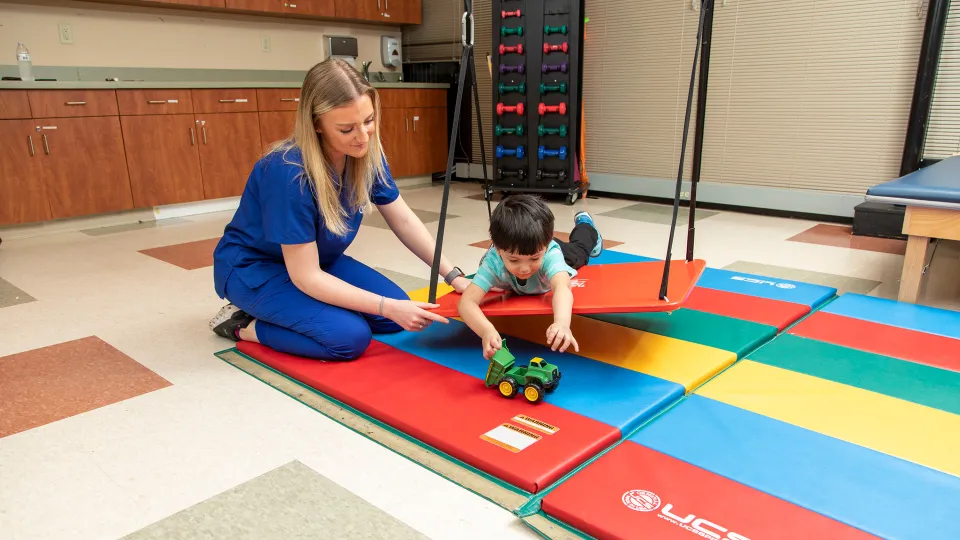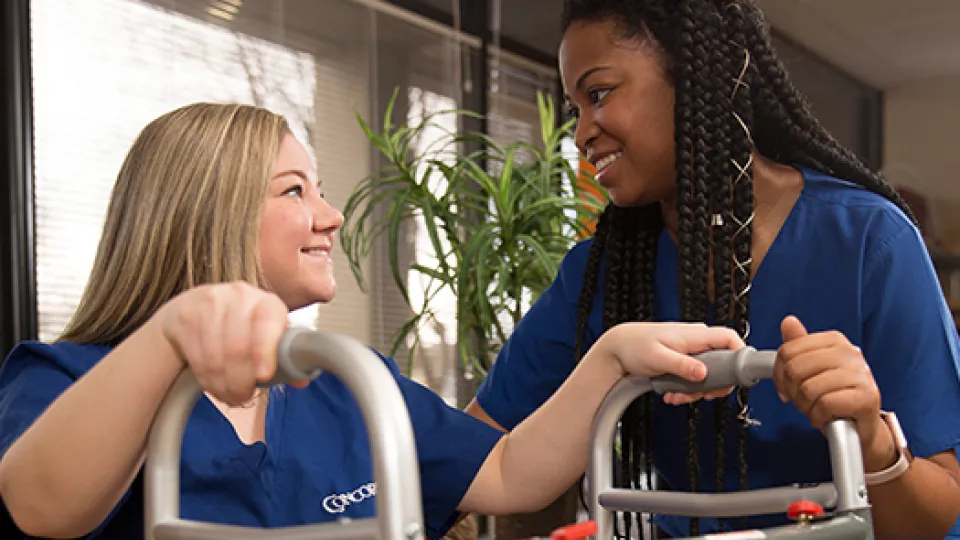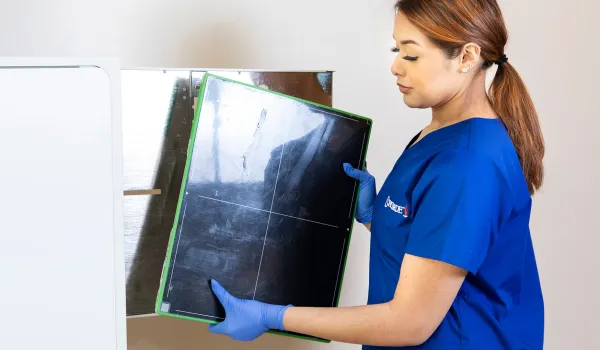
If you're interested in helping individuals regain independence and improve their quality of life, becoming an occupational therapy assistant might be the right career path. OTAs work alongside occupational therapists to provide hands-on support to patients recovering from injuries and managing disabilities. The role they play in hospitals and rehabilitation centers supports people as they regain essential skills for everyday living. To learn more about how to become an OTA, review this guide to find the education, certification, and licensure requirements necessary to enter this field.
OTA Educational Requirements

OTAs typically need to earn an associate degree from a program that's accredited by the Accreditation Council for Occupational Therapy Education (ACOTE) to qualify for certification and state licensure. While other programs are also available, an associate degree remains the standard path for entry-level practice. Most OTA programs take approximately two years of full-time study to complete. As of 2024, there are over 230 accredited OTA associate degree programs and 21 OTA bachelor's degree programs in the United States. These programs give students plenty of options to receive a high-quality education that meets industry requirements.
Core Coursework
OTA programs combine classroom instruction with hands-on training. Coursework often includes subjects such as:
- Anatomy and physiology: Anatomy and physiology classes provide a fundamental understanding of the human body's structure and functions.
- Introduction to psychology: This class explores behavioral and cognitive processes.
- Principles of occupational therapy: Students learn the fundamentals of occupational therapy practice in this type of class.
- Medical terminology and professional health care communication: Courses about medical terminology help students improve their health care-related vocabulary, while professional health care communication classes focus on developing interpersonal skills.
- Group dynamics, leadership, and cultural competence in health care: These courses prepare students to facilitate therapy groups and understand diverse patient needs.
- Business concepts in health care: Business courses such as this cover the administrative aspects of therapy services.
Throughout the program, students may also complete specialized OTA coursework. Examples include therapeutic use of occupations and occupational performance across life stages.
Fieldwork Requirements
Fieldwork provides students with hands-on experience in clinical settings. This supervised training gives them the opportunity to apply their knowledge in real-world scenarios and work with patients. Fieldwork often lasts several months and requires around 700 hours of supervised training to complete. Clinical placements may occur in hospitals, nursing homes, rehabilitation centers, schools, or outpatient clinics.
OTA Certification Requirements
OTA certification is required for professional practice in all 50 states. After completing an ACOTE-accredited OTA program, graduates must pass the National Board for Certification in Occupational Therapy exam to become a Certified Occupational Therapy Assistant or COTA. The NBCOT certification exam evaluates each candidate's knowledge and skills in patient assessment and intervention planning to make sure they meet the necessary OTA qualifications to work in clinical practice.
The exam is a four-hour, computer-based test with multiple-choice and clinical simulation questions. For first-time applicants, the exam costs $540. A minimum score of 450 is required to pass. In 2023, the first-time pass rate was 74%, with an overall pass rate of 87%. The NBCOT exam charges $430 for reapplications.
OTA State Licensure
State licensure is required to legally practice as an OTA in the United States, the District of Columbia, or Puerto Rico. Licensure is a separate process from earning the NBCOT COTA certification and is regulated by individual state boards. Most states require OTAs to:
- Graduate from an ACOTE-accredited OTA program
- Complete the necessary fieldwork requirements, which typically include 16 weeks of supervised clinical training
- Pass the NBCOT COTA exam with a minimum score of 450
On top of these requirements, some states may have additional stipulations. Examples include background checks, jurisprudence exams, and fingerprinting. It's important to check with the respective state licensing board to confirm any state-specific conditions. OTA licensure usually needs to be renewed every one to three years. Many states mandate continuing education credits as part of the renewal process.
OTA Skills and Qualities

Becoming successful as an OTA requires more than simply passing the certification and licensing requirements. It also involves the ability to connect with patients and problem-solve in dynamic environments. Here are some of the key skills and qualities OTAs may possess:
- Compassion and empathy: Working closely with patients who face physical, cognitive, or emotional challenges requires patience and understanding.
- Strong communication skills: OTAs collaborate with OTs, health care professionals, and family members to make sure patients receive the best care possible.
- Attention to detail: Precision is vital when it comes to following treatment plans and documenting progress to create safe therapy sessions.
- Adaptability: Every patient responds differently to therapy, so OTAs may have to adjust techniques and approaches based on individual needs.
- Critical thinking: OTAs assess the challenges their patients face every day to devise creative solutions that improve mobility and independence.
- Physical stamina: OTAs often assist patients with movement and exercises, which requires endurance and physical strength.
- Technological skills: Modern OTA practices often incorporate smartphone apps, video games, and robotic equipment designed to improve patient outcomes.
Related: Delivering Culturally Sensitive Healthcare Treatment
Career Outlook and Advancement Opportunities
The future for OTAs is bright, with the U.S. Bureau of Labor Statistics projecting employment to grow 19% from 2024 to 2034. This is significantly faster than the average growth rate for all occupations. The demand for OTAs is driven by an aging population that requires rehabilitation services. Increased awareness of how occupational therapy may help with developmental disorders and the need for cost-effective health care solutions are also driving factors. OTAs often work in various settings, including hospitals, outpatient clinics, and rehabilitation centers.
OTAs who work with children often practice at a school to help students with special needs develop motor skills and coordination. OTAs also work with seniors in nursing homes and in-home health roles to support mobility and daily activities. Experienced OTAs might be able to expand their careers through specialization and leadership roles to work with specific populations, such as pediatrics or geriatrics. Other specialization options include:
- Brain injury rehabilitation: This area supports people who are recovering from neurological injuries.
- Assistive technology: OTAs in this field implement devices that improve mobility and daily functions.
- Clinical liaison: In this role, OTAs coordinate services between health care providers and patients.
- Ergonomic consultation: In this specialization, OTAs assist OTs with advising businesses on workplace adaptations to prevent injuries.
OTAs with significant experience may transition into higher-level management and administration roles. For example, an OTA might become a Director of Rehabilitation, who typically oversees entire therapy teams to provide high-quality patient care. Another popular career path is to become an occupational therapy recruiter. In this role, OTAs may be in charge of connecting skilled occupational therapy professionals with health care organizations.
Related: Amy Marks: From Medical Assistant to OTA Success
Frequently Asked Questions About Becoming an OTA

To make sure you have all the information you need, review these answers to some frequently asked questions about becoming an OTA.
What's the Difference Between an occupational therapist and an OTA?
OTs evaluate patients so they can develop treatment plans and set therapy goals, while OTAs implement those treatment plans. They work directly with patients to help them improve their mobility, motor skills, and self-care abilities. While OTAs work under the supervision of OTs, they often have more hands-on patient interaction.
How Long Does It Take To Become an OTA?
The timeline to become an OTA varies based on the program. At Concorde Career College, you may complete the Occupational Therapy Assistant Associate Degree program in as few as 20 months.
How Can I Prepare for the NBCOT Exam?
The NBCOT exam covers assessment, intervention planning, implementation, and professional ethics. To prepare, many students take NBCOT practice tests. You can also complete review resources and participate in study groups.
Begin Your OTA Career Training With Concorde
Becoming a COTA requires dedication and a commitment to patient care. If you're ready to make a difference in people's lives and explore a rewarding health care career, Concorde offers an accredited Occupational Therapy Assistant program at Concorde - Memphis to help you build the skills you need to succeed. Take the next step today and contact us to learn more about our program and other health care career training opportunities.
Occupational Therapist Assistant (OTA) Certifications. (2025, August 13). MTS. https://www.medicaltechnologyschools.com/occupational-therapist-assistant/ot-assistant-certifications
Certification. (n.d.). Www.nbcot.org. https://www.nbcot.org/certification
Occupational Therapy Assistants and Aides : Occupational Outlook Handbook: : U.S. Bureau of Labor Statistics. (n.d.). Www.bls.gov. https://www.bls.gov/ooh/healthcare/occupational-therapy-assistants-and-aides.htm#tab-6
Take The Next Step Towards a Brighter Future
Interested in learning more about our Occupational Therapy Assistant program?
We have a Concorde representative ready to talk about what matters most to you. Get answers about start dates, curriculum, financial aid, scholarships and more!







